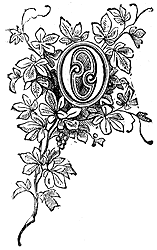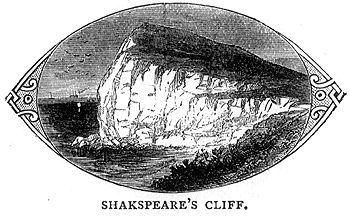 |
 NLY those who have returned home after a long absence in other climes can realise the rapture with which one sees the white cliffs of Albion rising from the sea in their calm majesty. The high cliffs of Dover are picturesque in the extreme, and were looked on by the Britons of the earliest times as the vanguard of the British defences. They had a rude fort there long before the invasion of Caesar. NLY those who have returned home after a long absence in other climes can realise the rapture with which one sees the white cliffs of Albion rising from the sea in their calm majesty. The high cliffs of Dover are picturesque in the extreme, and were looked on by the Britons of the earliest times as the vanguard of the British defences. They had a rude fort there long before the invasion of Caesar.
When threatened with invasion by Napoleon, the English Government put the castle into a state of strength sufficient to stand a siege by a modem army. The works then constructed consist of different batteries, containing a formidable train of artillery; casements dug in the solid chalk rock; magazines, covered ways, various subterranean passages, and lodging for 2,000 soldiers; light and air being conveyed by shafts and side openings through the rock to the face of the cliffs.
Within the Keep is an ancient well, said to be 310 feet in depth, and near it, within the Saxon works, are three other wells, nearly as deep. The large well is mentioned in the document by which the castle was surrendered to William the Norman.
The castle consists of two wards, an upper and lower, and occupies about thirty-five acres of ground. The lower ward is surrounded by an irregular wall or curtain, flanked at unequal distances by towers of different shapes. The oldest of these towers is said to have been built by Earl Godwin, the father of Harold, and still bears his name.
The Constable's Tower is the principal entrance to the lower court; this entrance has a deep ditch, crossed by a drawbridge, massive gates and a portcullis.
The Keep, re-built by Henry II., is very like the keep of Rochester Castle. It is in good preservation, and is used as a magazine. The walls are from eighteen to twenty feet thick, and in their thickness run galleries almost entirely protected from missile weapons. The summit of the keep is embattled, and at each angle is a turret. During the last wars it (the summit) was made bomb-proof, and several cannon are mounted on the top.
Near the edge of the cliff is a beautiful brass cannon, twenty-four feet long, cast at Utrecht in 1514, and presented by the States of Holland to Queen Elizabeth. It is called "Queen Elizabeth's pocket pistoll." It carries a twelve pound shot, but is quite unfit for use. There are several curious devices upon it, and some lines in old Dutch, which have been thus translated:
Shakspeare has left us a fine picture of Dover cliffs, with which we will close our description of them:
 It was from the cliffs of Dover that the Roman galleys approaching the shores of Britain were seen by the gallant people, who resolved to sell their lives and liberty dearly. They watched the invaders from these cliffs as they sailed along the coast to find a landing place, and following all their movements, descended. Sending their cavalry and war chariots before them, and marching rapidly after them with the body of their troops, they prepared to oppose the Romans' landing. Caesar, however, favoured by both wind and tide, determined to disembark his forces on the open flat shore between Walmer and Sandwich. But the Roman soldiers hesitated to leave their galleys (deterred according to Caesar's account by the depth of the water). The standard-bearer, however, of the famous tenth legion, was equal to the occasion. Shouting with a clarion voice, "Follow me, fellow soldiers, unless you will give up your eagle to the enemy; I, at least, will do my duty," he sprang into the sea, and dashed with his eagle into the ranks of the British. The soldiers instantly followed the heroic Roman, and the troops from the other galleys hesitated no longer. The contest that followed was a severe one, and Caesar himself acknowledges the valour of the Britons. They rushed into the sea to encounter and drive back the invaders; but Roman discipline and arms prevailed, and Caesar landed his two legions, and finally defeated the natives of the island.
He was unable to follow up his victory on account of the absence of his cavalry and a hollow peace was made with the Britons; but as we all know, the conquest of Britain was finally achieved. It became a Roman province, and one of the first buildings erected by the conquerors was a watch-tower or Pharos, which still exists on Dover cliffs. It is unmistakably a Roman work, and is now about forty feet high; but the upper part is more modern, and appears to have been added by Sir Thomas Erpingham (he who gave the signal to begin the battle of Agincourt), as he repaired the Pharos when constable of the castle in the reign of Henry V., and his arms are sculptured on the north front.
Close by the Pharos is an ancient church, generally said to have been built by King Lucius in the second century, but the walls are of a much later period, though Roman materials are worked up in them. The church has been restored by Government, and is now used as a garrison chapel.
The Castle is magnificently situated on the summit of a cliff more than 300 feet high. William of Normandy took possession of it immediately after the battle of Hastings. Creating his half-brother Odo, Bishop of Bayeux, Earl of Kent, he gave the castle into his custody, wisely considering it the key to the island. But Odo of Bayeux was a stern, tyrannical man, and much hated by the Saxons.
The men of Kent were not inclined to submit to him, nor, in fact, to William himself, and they resolved to retake their castle They sent to Eustace, Count of Boulogne, entreating his aid; it was readily yielded, and the count managed to cross the Channel unobserved by the Normans. The Kentish men met him on the shore. He had brought a number of scaling ladders, intending to surprise the fortress. They were descried, however, by the soldiers in the castle, who allowed them to approach and to begin scaling the wall; but then they opened the gates, sallied forth, and attacked the assailants with such fury that Eustace and a few others were the only ones who escaped. They succeeded in reaching their ship, but the rest were either slain by the sword, crushed by falling from the cliffs, or "devoured by the sea."
A terrible scene Dover cliffs must have presented on the dawn of the next morning.
Odo of Bayeux being suspected by William of disloyalty or treachery, was sent prisoner by him to Normandy, and his possessions were confiscated; the king seized Dover Castle and fortified it anew, appointing not one custodian, but nine. These were trusty knights, who by tenure of lands were each bound to find and maintain a hundred and twelve soldiers; and they were appointed to perform watch and ward, each in particular towers, turrets and bulwarks, which bore the names of their respective captains.
Henry II. rebuilt the keep, and refortified the castle. It was twice besieged by Louis the Dauphin, when he was called over by the discontented barons in John's reign, but it was so gallantly defended by Hubert de Burgh, the governor, the first time with a garrison of only a hundred and forty soldiers and his own servants, that the French retired with loss. Once again Louis besieged Dover Castle, and this time endeavoured to bribe Hubert to surrender it to him; but De Burgh was inflexibly honest and treated his offers with contempt. Our readers will recognise in Hubert de Burgh the Hubert of Shakspeare's magnificent tragedy of King John."
But though Dover Castle was saved from the surprise intended by Eustace de Boulogne and the men of Kent, it was not so fortunate during the civil war in Charles I.'s reign. A certain merchant, named Drake, resolved to obtain possession of it for the Parliament, and on the night of August 1st, 1642, with the aid of only twelve men he resolved to make the attempt.
The cliff on the seaside being considered inaccessible, was left unguarded. The brave Drake, with ropes and scaling ladders led his followers up this terrible path in the faint starlight. They succeeded in reaching the top unobserved, and he instantly made his way down to the entrance; here he seized the sentinel, and threw open the gates. The officer on duty believing that Drake had a strong force with him, and that resistance was hopeless, surrendered at discretion. Drake immediately despatched messengers to Canterbury, where Lord Warwick was with his troops, and the Earl instantly sent him one hundred and twenty men to help him retain the castle. The Royal forces shortly after besieged the daring conqueror, but the Parliament sent a superior force to his relief, and the Royalists were compelled to raise the siege.
This is the last adventure recorded of Dover Castle.
|
 |